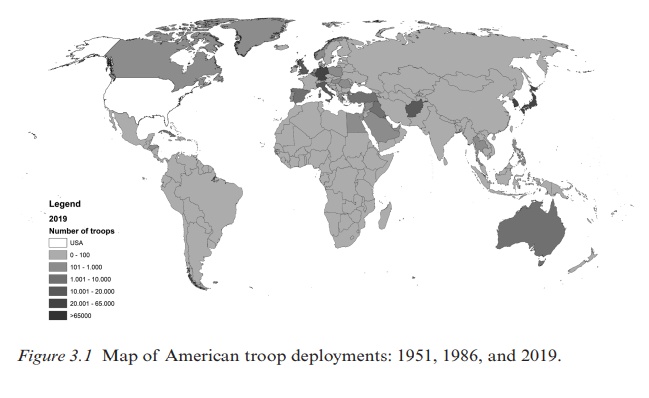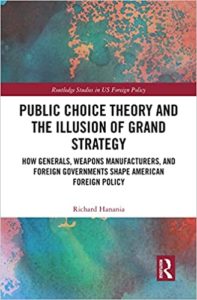

Richard Hanania’s new Public Choice Theory and the Illusion of Grand Strategy is an eye-opening contrarian take on the academic discipline of “international relations.” It is a self-conscious critique of the so-called “realist” view that countries maximize their long-run national interest. In the next three posts, I’ll share some highlights.
The central argument:
[T]his book argues that both primacy and liberal internationalism are labels put on a collection of policies that are not primarily motivated by geopolitical goals. The public choice model provides a better explanation of US policy than that of grand strategy. Decisions are made mostly on the basis of short- term political considerations, with a playing field tilted by concentrated interests.
Different interest groups control different aspects of U.S. foreign policy, making U.S. foreign policy simply incoherent.
[I]n dealing with rising powers, the United States adopts a strategy of what I call build, then balance. It trades with such countries, helping them become wealthier, and then balances against them when economic power is translated into military capabilities.
For example, U.S. business mostly controls trade policy, but the military-industrial complex handles military affairs.
Even more than in other areas, voters cannot simply “trust the experts” because the questions are too complex:
There is no experiment or study that can conclusively speak to many of the large questions in the field of IR. How can we know for certain whether the US presence in East Asia deters the Kim regime or needlessly provokes it? Or whether a world without American hegemony would spin into chaos, or see various regional actors come together and largely work out their differences peacefully? One can uncover statistical relationships through large-N studies, and this can at best provide some guidance if we trust the methodology. Nonetheless, one can always argue that a relevant causal relationship is unlikely to apply in any given case, or even that with changes in technology, culture, and international norms over time, it cannot be established with certainty that a causal relationship established between one variable and another in one era provides any guidance for the contemporary period.
Thus:
Consider that at the end of 1945, an observer would have had a great deal of data suggesting that in the coming decades there would be great power wars, and also that when wars were fought the combatants would use the most effective technologies possible against their opponents. Such predictions would have been consistent with the way nations have behaved across recorded history. Yet since that time, there have been no great power wars, and no use of nuclear weapons either (Hanania 2017 ; Pinker 2012). Why is this the case? No one can say for sure. Although some IR theorists credit nuclear weapons with keeping international peace, this is difficult to square with the fact that there have been multiple cases of nonnuclear powers attacking nuclear states without any apparent fear of retaliation (Paul 1995). Given that the list of technological, political, and cultural changes in the world since 1945 is practically endless, pinning down what exactly has determined our unprecedented run of great power peace may be impossible.
Cool details on the “iron triangle“:
Bender (2010) found that between 2004 and 2008 around 80% of retired three- and four- star generals went on to work as consultants or executives in the defense industry. This was up from about 50% in the period from 1994 to 1998. Moreover, many of these generals see overlap between their careers in government and the private sector, further raising conflict of interest issues. Bender found dozens of generals who maintained Pentagon advisory roles while working for corporations, often being recruited into the private sector before retirement. The practice of “rent-a- general” is so well- developed that some niche companies have emerged, including the Four Star Group, in which generals use their experience and contacts within the Pentagon to make profits in equity investing.
Chomsky’s a realist, and he’s wrong:
In order to fi nd a “grand strategy” in American behavior, observers have had to be creative. Chomsky acknowledges that Serbia had no direct strategic or economic value, but compares the United States to a mob boss who occasionally must stamp out any signs of disrespect (Chomsky and Barsamian 2010: 54). In this way, practically any intervention can be labeled as part of a “grand strategy.”
To grasp Hanania’s central thesis, just look at a map:
In addition to investigating under which conditions the United States uses force, it is interesting to consider the issue of American troop deployment. Are the patterns we see consistent with a grand strategy, or a public choice model? According to the Defense Manpower Data Center, not including active war zones, as of September 2019 the United States had about 200,000 soldiers stationed abroad. The top five countries with the largest American presence were Japan (62,482), Germany (47,066), South Korea (29,565), Italy (15,411), and the United Kingdom (10,586). These states hosted over 80% of American military personnel stationed abroad. In 1951, during the Korean War, the top five countries were South Korea (326,863), Germany (176,084), Japan (172,861), the United Kingdom (26,313), and France (22,876); though the total numbers are different, the bulk of American forces 30 years after the Cold War are in almost exactly the same places they were at its beginning (see Kane 2004 )…
Looking at the maps reveals an interesting pattern. What was happening in the world in the 1940s and 1950s is a better guide to American troop distribution abroad today than anything that has happened since. The top four countries with the largest American presence are the nations that were the main members of the defeated Axis powers and the country that the United States defended in the Korean War half a decade later. It seems very unlikely that the strategically most important parts of the world in 2019 were those that happened to require the largest American troop presences in the 1940s and early 1950s. There is no strategic threat to Italy, and the threat that kept the United States in Germany after World War II has disappeared. (emphasis mine)
This inertia fits a broader pattern of foreign policy incoherence:
American policy does not appear to be driven by a quest for global supremacy either. This is particularly true in the conflicts since the end of the Cold War. Afghanistan can be justified as part of the war on terror. Iraq did not in any way increase American power; in fact it empowered Iran. The United States was not even willing or able to ensure that American corporations would profit from Iraq’s oil reserves, discrediting the claim of anti- war activists that the United States was spilling “blood for oil” (Walt 2009 ). In Libya, Mummar al-Gadhaffi had made a surprise announcement in late 2003 to dismantle his weapons of mass destruction (WMD) program. He became an ally in the war on terror and made amends for terrorist attacks decades earlier as Libya was declared a success for the Bush administration (MacLeod 2006). When he was overthrown in 2011, it was a clear signal to every other dictator in the world who might otherwise be tempted to trust the United States on matters of national security. North Korean officials years later specifically cited Libya as a reason not to give up their nuclear deterrent (Specia and Sanger 2018).
More highlights later this week.

READER COMMENTS
Brandon
Feb 1 2022 at 11:28am
Hanania is a bright thinker, especially his thoughts on the randomness of American military bases throughout the world, but his analysis is still bogged down by Westphalian logic.
I say it’s high-time libertarians borrow a page from James Madison’s playbook and start thinking of ways to abrogate nation-state sovereignty.
Looking forward to more posts on this, and more discussion on foreign policy in general…
Mark Z
Feb 1 2022 at 2:38pm
One aspect of this thesis I’m skeptical about is the idea that the ‘military industrial complex’ drives foreign policy. Just because a bad policy is lobbied for by an invested industrial lobby doesn’t mean the lobby drives the policy. Do we have so many farm subsidies because of the agricultural lobby? Is support for public school funding attributable to teachers’ unions? In both cases, partially, but I’d bet at least as much because farmers and schoolteachers are popular among voters. There are also industries that would benefit from the opposite policies, but they don’t have popular support. I think the same is largely true of foreign policy. Voters like politicians who seem strong and confrontational to our national rivals; without the interest groups lobbying, I speculate we’d still see a pattern of irrational intervention.
I also think Hanania’s point about the geographical distribution of forces is weaker than he thinks. US troops remained in Europe after WW2 mainly because of our rivalry with Russian and, well, Russia is still our rival. Japan is no longer a rival, but China right next door is, and even in the late 40s, one of the main reasons the US put so many troops in Japan was fear of communist incursions, though more Russia than China at first. Our main rivals today, IOW, are in the same places they were 70 years ago.
MikeDC
Feb 2 2022 at 10:45am
I also think the geographic argument is very weak.
There’s significant fixed costs to positioning a military. Maybe it’d be strategically slightly better to relocate German forces to Poland or Greece, but this would be expensive as well as politically provocative.
At the same time, technological advance means that the relative advantage of forward positioning might be lower.
So yes, it’s inertia, but there’s also legitimate reasons for inertia. I think this gets to my overriding thought as well… we’d like for their to be THE REASON but usually there are many reasons and they aren’t just “not exclusive” they’re complementary. Reducing an argument down to “THE REASON” ends up weakening the argument pretty significantly.
ksdale
Feb 2 2022 at 12:48pm
I think there’s a case to be made that farmers and teachers are popular with voters *because* of the lobbies.
I don’t know a ton of farmers personally, but the ones I do know are emphatically average small business owners (and the vast majority of farming is not done by the more sympathetic small business owners…), but for some reason, there’s a mystique surrounding farming.
I’ve also liked all of my kids’ teachers, but when you consider how much is spent per student in my state, and what sort of education the average kid receives, it’s also not *super* congruent that opinions of teachers are so high?
Comments are closed.